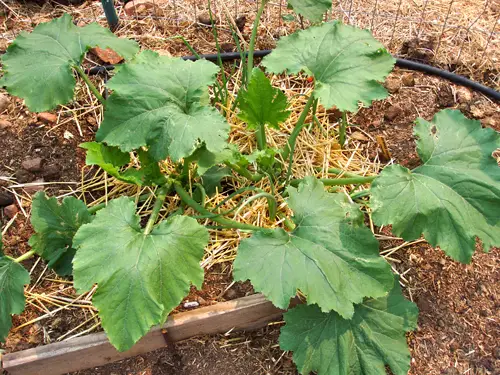Costata Romanesco: Everything You Want to Know
Have you ever seen a zucchini that looks like it belongs in a modern art museum? Enter Costata Romanesco, the heirloom squash with a personality as big as its flavor!
This unique variety boasts stunning ribbed exteriors and a taste that will have you wondering why you ever settled for regular zucchini. Intrigued?
Let’s explore the wonderful world of Costata Romanesco, from its fascinating history to growing it yourself.
Jump to section:
What is Costata Romanesco?

Costata Romanesco, which translates to “ribbed Roman” in Italian, is an heirloom variety believed to hail all the way back to 16th century Italy. That’s some serious gardening pedigree!
Imagine the lineage of this squash – perhaps it graced the tables of Renaissance nobility or inspired creative cooks during a bygone era. Now, you can be a part of this history by cultivating your own Costata Romanesco and savoring its unique flavor in your home kitchen.
Unique Characteristics
This isn’t your average zucchini. Costata Romanesco stands out with its:
- Visually striking ribbed exterior: Forget smooth skin, this squash is all about ridges and curves, earning its Romanesco namesake.
- Creamy yellow flesh with a mild, nutty flavor: Similar to zucchini but with a touch more sweetness, it adds a delightful depth to your favorite dishes.
- Compact plant size: Don’t have acres of land? No problem! Costata Romanesco is perfect for smaller gardens, growing happily even in containers.
Benefits of Growing Costata Romanesco
Here’s why you should consider adding Costata Romanesco to your garden:
Easy to Grow and Maintain
Even if you’re a rookie gardener, you can be a Costata Romanesco pro! This low-maintenance variety is forgiving and thrives with minimal fuss.
No need to worry about complicated care routines or spending hours in the garden – Costata Romanesco is happy with consistent watering, some sunshine, and the occasional feeding.
Prolific Producer
Costata Romanesco is a prolific producer, meaning you’ll be rewarded with a continuous stream of delectable zucchinis throughout the growing season.
Unlike some vegetables that offer a single harvest, Costata Romanesco keeps on giving, allowing you to enjoy fresh squash in all your favorite dishes for weeks on end.
Versatile in the Kitchen
This veggie is a culinary chameleon, adapting to a wide range of cooking methods.
Roast it for a caramelized sweetness, grill it for smoky depth, or sauté it for a quick and flavorful side dish.
Feeling adventurous? Try spiralizing your Costata Romanesco for a healthy, gluten-free noodle alternative that will add a touch of elegance to your next pasta dish.
How to Plant and Grow Costata Romanesco in Your Home Garden?

Growing Costata Romanesco is like embarking on a seed-to-squash adventure! Here’s how to cultivate these beauties in your garden:
When to Plant
Before you grab your seeds and dash outside, hold on a sec. Timing is key!
Since Costata Romanesco is a summer squash, you’ll want to plant it after the danger of frost has passed. This typically falls in late spring or early summer, depending on your local climate and last frost date.
Pro tip: Want to get a head start? You can actually sow seeds indoors 4-6 weeks before transplanting them outdoors. This allows them to mature a bit before facing the elements.
Choosing a Planting Location
Happy plants mean happy squash! Here’s what your Costata Romanesco needs to thrive:
- Full sun exposure: At least 6-8 hours of direct sunlight per day is essential for optimal growth and yield.
- Well-drained, fertile soil: Think rich and fluffy! Amend your soil with compost or aged manure if needed to ensure proper drainage and provide essential nutrients.
Planting Process
Now for the fun part – planting! There are two ways to go about this:
Option 1: Direct Sowing – A Speedy Start
For the impatient gardener (or those short on space), direct sowing is the way to go. Here’s how to get your seeds off to a flying start:
- Prepare the Soil: Imagine your Costata Romanesco basking in luxury. That’s the kind of soil you want to create! Aim for loose, fertile soil with good drainage. Amending your soil with compost or aged manure a few weeks before planting is a great way to achieve this.
- Temperature Check: Make sure the soil temperature has reached a cozy 70°F (around 21°C) – this warmth encourages happy germination.
- Sow and Water: Plant your seeds directly into the prepared soil, following the recommended spacing on the seed packet (typically around 2-3 inches apart). Gently water the planted seeds – you want the soil moist, not soggy.
Option 2: Transplanting Seedlings – The Indoor Nurture
If you have a little more time and want to give your seeds a head start, then consider transplanting the seedlings.
Here’s how to nurture your future squash superstars indoors:
- Sow Indoors: 6-8 weeks before the last frost date, sow your seeds in well-draining seed trays or pots filled with a quality potting mix. Keep the soil moist and provide plenty of warmth and sunlight (around 16 hours a day) – a sunny windowsill or grow lights work wonders.
- The Transplant Tango: Once your seedlings have developed a few true leaves and look sturdy, it’s transplant time! Harden them off first by gradually exposing them to outdoor conditions for a few days before their big move to the garden. This helps them adjust to the transition.
- Planting Party: When all danger of frost has passed, prepare your planting bed as described for direct sowing. Gently transplant your seedlings, ensuring they’re planted at the same soil depth they were growing indoors. Water them thoroughly to help them settle in.
Whichever planting method you choose, don’t forget the magic of labeling! Clearly mark your planting area with the variety name (Costata Romanesco, of course!) and the planting date. This will be a lifesaver come harvest time, especially if you’re planting a veggie garden extravaganza.
Here are some more planting guidelines:
- Spacing: Provide enough room for your plants to grow. Space them 24-36 inches apart in rows 3-4 feet apart.
- Watering: Water your seeds or seedlings thoroughly after planting.
Growing Tips for Success
Now that your Costata Romanesco is nestled in its new home, here’s how to cultivate thriving plants and a bountiful harvest:
Watering
Imagine your Costata Romanesco like a thirsty athlete – it craves consistent moisture, especially during hot, dry periods. The key is to strike a balance.
Deep watering at the base of the plant, rather than a daily sprinkle, is the way to go. This encourages the roots to grow deep, searching for moisture, and ultimately leads to a stronger, more resilient plant.
For best results, water the soil directly at the base of the plant and avoid wetting the leaves as it may lead to fungal disease.
Pro Tip: Sticking your finger into the soil near the base of the plant is a great way to gauge moisture levels. If it feels dry after reaching the first knuckle, it means your plant’s thirsty.
Fertilizing
While Costata Romanesco isn’t a heavy feeder, a little extra nourishment can go a long way. Consider feeding your plants a balanced fertilizer every few weeks during the growing season. Think of it like giving your squash a vitamin boost for optimal growth and fruit production.
Organic Options: For the eco-conscious gardener, organic fertilizers like compost tea or homemade nitrogen fertilizer are a fantastic choice. They provide essential nutrients while nurturing the soil microbiome – a win-win for your plants and the environment.
Weeding and Mulching
Weeds – the uninvited guests at every garden party!
Regular weeding is essential to prevent these unwanted visitors from stealing precious resources from your Costata Romanesco. Hand-pulling weeds is a great way to stay on top of them, but for larger infestations, a gentle hoeing between plants can be effective.
What’s more? Mulch is your gardening BFF! Apply a 2-3 inch layer of organic mulch (like straw, shredded bark, or compost) around the base of your plants. This magic potion acts like a mini-ecosystem, retaining moisture in the soil, suppressing weed growth, and regulating soil temperature – all essential for happy, healthy Costata Romanesco.
Pollination: The Birds and the Bees (and Your Costata Romanesco!)
The beauty of Costata Romanesco is that it’s an open-pollinated variety. This means that pollen is transferred naturally by pollinators like bees, butterflies, and even hummingbirds.
To attract these helpful visitors, consider planting companion flowers near your Costata Romanesco. These colorful blooms will create a pollinator haven, ensuring a steady stream of busy bees buzzing around your squash plants, leading to bountiful harvests.
Bonus Tip: If you’re dealing with limited space or hand-pollination is your preferred method, don’t worry! Costata Romanesco has both male and female flowers on the same plant. You can carefully transfer pollen from the male flower (identified by its thin stem) to the female flower (with a small fruit at its base) using a cotton swab.
Conclusion
Costata Romanesco is a truly unique and rewarding heirloom squash to grow. It’s easy on beginners, delivers a continuous harvest, and adds a touch of elegance (and flavor!) to your garden. So, why not give it a try?
In a future article, we’ll delve into the exciting world of harvesting and using Costata Romanesco in your kitchen. Get ready to create delicious dishes that will tantalize your taste buds!
Costata Romanesco FAQs
What does a Costata Romanesco taste like?
Costata Romanesco has a mild, nutty flavor similar to zucchini, but with a hint of sweetness. Many gardeners find it more flavorful than regular zucchini.
How big do Costata Romanesco zucchini get?
They typically mature to be 6-8 inches long, with a diameter of 2-3 inches.
Can I eat Costata Romanesco raw?
Absolutely! Slice it raw for salads or crudité platters.
Is Romanesco easy to grow?
Yes! Costata Romanesco is considered a beginner-friendly squash variety.
What temperature does Romanesco grow in?
Costata Romanesco thrives in warm weather, with ideal temperatures between 70-90°F.
Why is Romanesco so expensive?
Commercially grown Costata Romanesco may be more expensive due to its lower yield compared to some other squash varieties. However, growing your own is a cost-effective way to enjoy this unique vegetable.
Can you grow Romanesco in pots?
Yes, you can! Choose a large pot (at least 20 gallons) with good drainage and provide plenty of sunlight.
Where is Romanesco found?
Costata Romanesco seeds are readily available from online retailers and some garden centers.

